Group Activities in the Dalcroze Lesson
Perhaps the most enduring negative side effects of the recent pandemic were caused by the social isolation. Families were segregated during illnesses, schoolchildren were separated from their peers, and communities suffered permanent losses of their members. I found myself missing even the most basic, mundane tasks like grocery shopping, taking my children to local playgrounds, and going out to the library. Until the global shutdown, I hadn’t truly realized how much I need to interact with others out in public. Humankind is not just about the personal, individual experience; equally important are our relationships with other human beings.
One of the joys of Dalcroze education is that it is practiced en groupe. Dalcroze practitioners purposefully create activities involving group interactions to enhance learning. This aspect is so important to the work that collaborating with peers is both a teaching strategy and a core pedagogical principle. For a classically trained pianist who grew up learning and understanding music as a solitary venture—one-on-one lessons with my teachers, solo recitals and competitions, and hours alone in the practice rooms—Dalcroze work was exciting in that we were expected to interact with our classmates. It soon proved very valuable and enjoyable for me to cooperate and create with my peers multiple times each lesson in activities such as improvisation, invention, and problem-solving.
Humankind is not just about the personal, individual experience; equally important are our relationships with other human beings.
Dalcroze Strategies and Group Activities
What is Dalcroze education? Many would say that it is an experience in which many or most Dalcroze pedagogical principles (which include social interaction and a spirit of play/joyfulness, among others) are present. To achieve this goal, Dalcroze practitioners incorporate a wide variety of Dalcroze teaching strategies. While the Dalcroze principles and strategies may slightly differ in name and definition around the world, the Dalcroze Society of America has spent the past decade codifying the principles and strategies important to American practitioners into an accredited Dalcroze teacher training curriculum (the T2 program) and are currently working to define each of these, along with examples.
As a Dalcroze teaching strategy, “group activity” is fairly straightforward: whenever a student is participating in an activity while communicating with another student or small group is my interpretation. Most often, Dalcroze teachers will design an exercise that pairs a group activity alongside another teaching strategy to help the students achieve a goal, whether that is internalizing a difficult dissociation (where the body does two different things at once, for example), creating a moment of improvisation, or simply socialization and team-building.
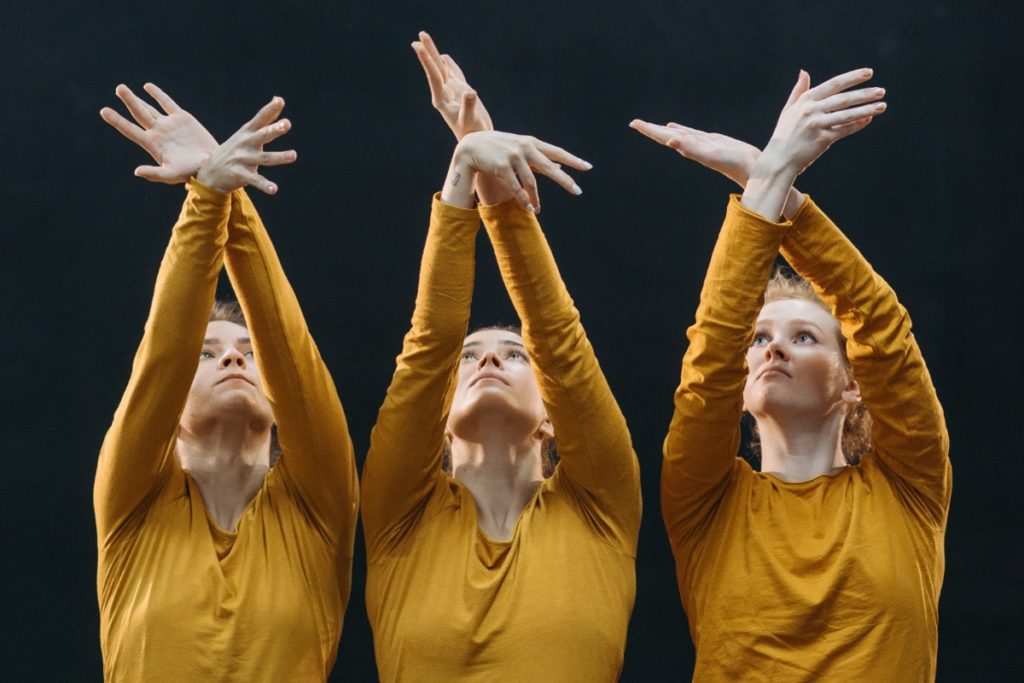
Association
Association is the teaching strategy that asks students to coordinate two or more elements occurring at the same time: matching the rhythm of one’s feet to the rhythm of the piano; singing while showing the melodic contour of the pitches in space with hand gestures; or matching the gestures of another in the space, for example.
Associations are one of the most important Dalcroze teaching strategies and often occur in several activities throughout a Dalcroze lesson. Oftentimes, associations are the first step toward mastery of a more difficult teaching strategy, like a systemization, inhibition/incitation, or a dissociation. However, when students not only move in association with the music but also within the larger group, the association becomes an extremely powerful tool for immediate nonverbal feedback.
This is one reason that Dalcroze education is almost always practiced in groups: because moving together in association with one’s peers is a way for a student to check their work with the other students. Am I doing what everyone else is? Am I wildly different? Do we all match each other? Students in groups can use their peripheral vision to instantly get feedback about their own movements and interpretation of the activity.
The majority of my lessons with early childhood Dalcroze students (infants to preschoolers) consist of combined associations and group activities, usually accompanied by singing a wide variety of songs. These young learners, accompanied to class by a caregiver, oftentimes prefer to sit in a lap and observe each lesson’s songs and games before participating. Some parents begin to worry that their children aren’t participating and thus aren’t interested or learning (even though this behavior is developmentally normal for this age).
To motivate the students to participate, many, if not most, of the activities I design require the entire group to move together in association, whether in locomotion or gesture. Over time, as children observe their peers participating, they eventually became motivated to not be left out. This is a type of peer pressure association and group activity where the goal is for all children to eventually participate. For many of these young learners, this class might be their first-ever classroom experience in any subject, and asking them to participate can be a formative experience to encounter—the nonverbal cue of seeing the rest of the class moving as a group is a powerful tool to help students.
Once children have started to participate within the group, I next try to get them to separate from their adult. Again, using group activities can help the students to feel more comfortable doing so. In an activity known as a type of Dalcroze spin-off, children sing a song while gesturing with their caregiver; in the improvised interludes between songs, the child locomotes freely through the space with the other children while the adult remains seated. Games like this have the child moving in association with a caregiver or moving in association with their peers. The element of moving as part of a group can help the students to feel safe in their choice to move.
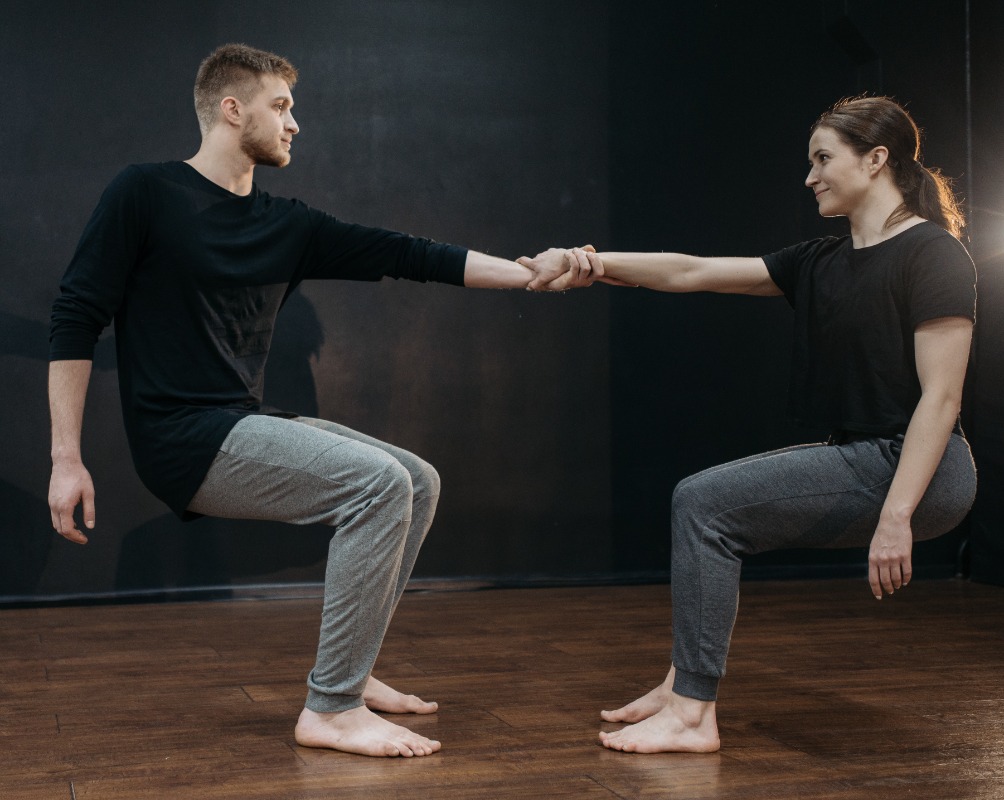
Incitation/Inhibition
Incitation/inhibition is the Dalcroze strategy in which a student has to wait and then (at a cue) perform a specific action. This teaching strategy not only helps students to internalize the musical topic at hand, but also aids the teacher in assessment: If a student can successfully perform an inhibition/incitation activity, they most likely understand the concept.
Inhibition/incitation games can be strengthened via use of the group. In my own teaching, this oftentimes turns into games consisting of small teams: group A stands in this corner and only moves the beats; group B stands over by the door and only moves the divisions; group C stands by the piano and only moves the multiples. Children ages four to six benefit from this challenge early on in their eurhythmics studies after they have moved in association to these three rhythms for a few weeks, because they will have to not only listen carefully and analyze the rhythm, but also remember if it belongs to their team. Visually receiving feedback from others in their group is an effective way for these young learners to master this quick analysis and memory game.
For older students, I use group inhibition/incitation activities in the form of rhythmic turn-taking: passing a beanbag around a circle to the pulse, or waiting in line for your phrase to leap rhythmically across the hall, for example. In this way, the students learn to actively wait for their opportunity to participate while also receiving visual (as well as aural) feedback for how long they anticipate waiting.

Orientation of the Space
Dalcroze teachers use orientation of the space to demonstrate musical concepts. Within the Dalcroze hall, students can be directed to position themselves in relation to the space, the others occupying that space, and the musical topic. This can be done by spatially creating boundaries, rules, or limitations. For example, one could set directions for locomotion: skip in a large circle but move in straight lines back and forth from one wall to the other when the music changes to marching.
When practiced in groups, this strategy is an effective teaching technique. When working with four-to-six-year-olds, I spend quite a long time at the beginning of each session on forming standing circles while holding hands. It takes practice for some children to use their peripheral vision and coordinate their hands to form the class circle before the circle song is over and time is up! This is a group effort that uses space purposefully, especially when paired with directions: form a circle in the back corner of the room; form a circle under a light bulb; form a small, tight circle; form a large, spacious circle; etc.
Improvisation
Moments of improvisation as a teaching strategy are incredibly useful and joyful. Oftentimes, improvisation is employed as a teaching strategy toward the end of a lesson or unit, where the teacher gives the students a chance to play around with the material they’ve been given earlier. In these situations, students synthesize the information they’ve gleaned throughout the course of the lesson and manipulate the material freely, creating something they now have ownership over.
When improvisation activities are done in groups, the students now also have a chance to communicate with others musically. New ideas emerge when collaborating with one’s peers, and creativity can abound. Leadership roles naturally emerge, as well as the chance for gracious, conciliatory problem-solving. Group activities in improvisation exercises are an incredibly valuable aspect of our work.
Some powerful group improvisation activities that I personally experienced as a Dalcroze student were those based around vocal improvisation. I once attended a powerful workshop with Françoise Lombard in which the group was singing sustained tones and improvising whether to move one’s pitch up or down by half step. The effect of the improvised group harmonies was extremely beautiful and unexpected in their development. For beginning Dalcroze students, creating improvised vocal melodies within a small group or pair is also an effective way for students to feel safe in trying out new ideas with one’s voice while also hearing other ideas from their peers.
In the instrumental improv setting, I enjoyed my classes with Pascal Chenu (faculty at l’Institut Jaques-Dalcroze) where he asked the group to improvise with auxiliary percussion instruments (egg shakers, small tambourines and drums, finger cymbals, etc.) while one or two students played at the piano. The improvised percussion section not only kept the rest of the class engaged during someone else’s “solo,” but also added to the overall character and enhanced the mood of the piano music. Grooving all together made the music come alive and also forced the pianist to keep going even when he or she wanted to stop!
As a teacher, I find it effective to ask students to improvise movements or gestures to a particular rhythm, meter, or melody as part of a group, eventually, without discussion, settling on one common movement. Being together in a group seems to help push students out of their comfort zones and explore new movements.
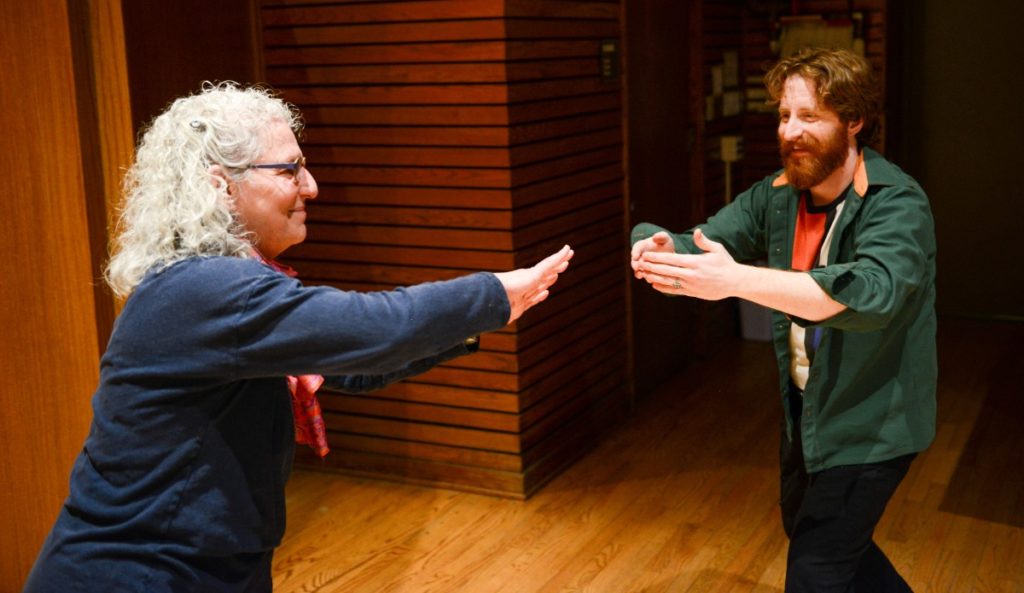
Joy and the Spirit of Play
One of the most intriguing of the pedagogical principles is the incorporation of the element of joy and the spirit of play into each Dalcroze experience. As a novice Dalcroze teacher, I found it difficult to plan for moments of joy in my burgeoning lessons: How could I know when my students would have fun? Over time, however, I discovered that Dalcroze students typically start to relax, smile, maybe even laugh, and otherwise show feelings of joy while participating in almost any type of group activity. Being able to interact with one’s peers affords students the opportunity to relate to one another, create together, and hopefully have an enjoyable experience while doing so. Students learn best when they are feeling open-minded, and feelings of joy create opportunities for open-mindedness. To facilitate this type of learning environment, well-planned group activities are crucial!
Planning for Group Activities
There are some considerations to make when designing a group activity. The Dalcroze teacher can either let students self-select their groups or can purposefully sort the students based on the needs of the class: stronger students with weaker; parents with their children; veteran Dalcrozians with newbies, etc. These parameters can help combine the effects of a group activity with team-building skills, where stronger students help weaker students without teacher intervention.
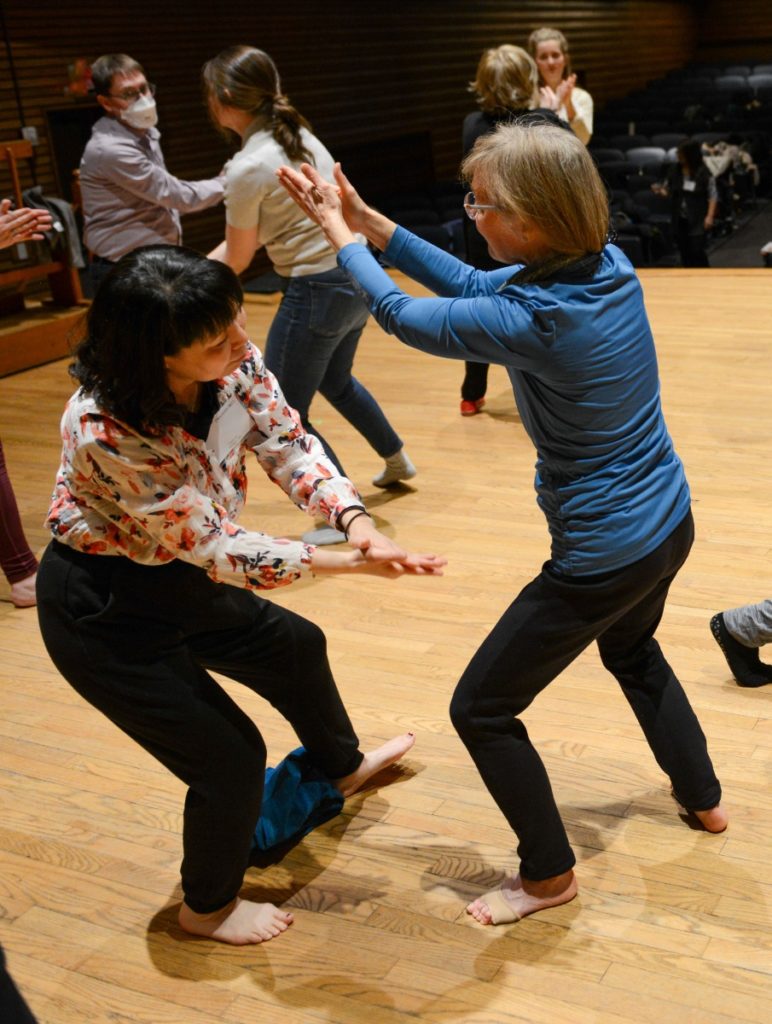
Another factor to consider in the lesson planning stage: What happens if you design a game for pairs but your class numbers are in the odds? How can you adapt a partner activity for three? It helps to think this through before you are in the heat of the moment, as this is almost a weekly occurrence in my teaching.
In these types of scenarios, I typically ask two of the three students to share a role: for example, if the activity is tapping or painting rhythms on the back of another student, then I will have one painter and two canvases. If the activity is a game where student A taps the drum of student B, then I will have student B hold two drums that two student As will tap. It is important to switch the roles of the students enough times so that all members of the group of three will have a chance to fulfill all roles in the game.
It is also important to consider the timing of the group activities within the lesson. Starting a class with a group activity aims to help students feel more comfortable around each other and thus open to learning and experiencing in new ways. When working with new students, I always begin with some sort of group interaction so that the students can quickly become better acquainted. Even with returning students, it is fun to begin a Dalcroze session this way, and fun puts people in the mood to learn and create. Common Dalcroze openers in adult classes include playing a gesture-based name game, shaking hands with others at a signal during locomotion, or even simply making eye contact with others as you pass in the space.
Similarly, ending a class with a group activity creates feelings of goodwill and accomplishment, and sends the students away in high spirits, ready to return. I like to end adult Dalcroze classes with a folk dance or plastique animée experience, where the students have to work together in some way to achieve a goal.
Moving in a group, interacting with a group, and learning together with one’s peers can be a powerful and meaningful experience.
Group Activities Can Build Community
Purposefully planned group activities will increase the spirit of joy and raise the overall energy of the class. Students enjoy the opportunities to be self-directed after having listened to a teacher both verbally and musically for the majority of the class, and working with one’s peers helps some students flourish, especially creatively.
Group activities will also provide variety and lend a multitude of learning experiences to your students. The problem-solving skills that arise from working with others, as well as the team-building skills and creativity that can result, support students in realizing more potential both musically and socially. Moving in a group, interacting with a group, and learning together with one’s peers can be a powerful and meaningful experience.
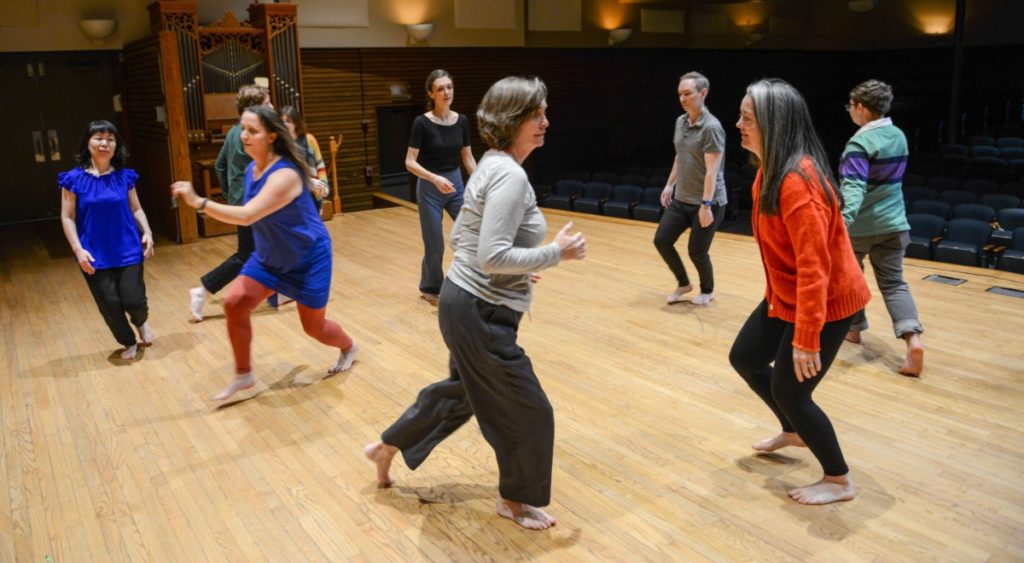
The pandemic made me realize just how sorely we need not only everyday social interactions but also a greater sense of community. The human experience is not just about personal participation; a sense of community and feelings of fellowship have enhanced the quality of my own life.
Humans are social creatures and aren’t meant to be isolated from one another, even if there is a visual connection via computer screen. The energy of being in the same room as others is a powerful force and one that we truly need. Luckily for our students, simply participating in a Dalcroze lesson is a special kind of group music learning that isn’t necessarily available to private instrumental students. Part of what makes Dalcroze work special is the fact that we get to learn, experience, and create with others, thus nurturing a sense of community and camaraderie.
This article was originally published in the Fall 2023 issue of Dalcroze Connections, Vol. 8 No. 1.